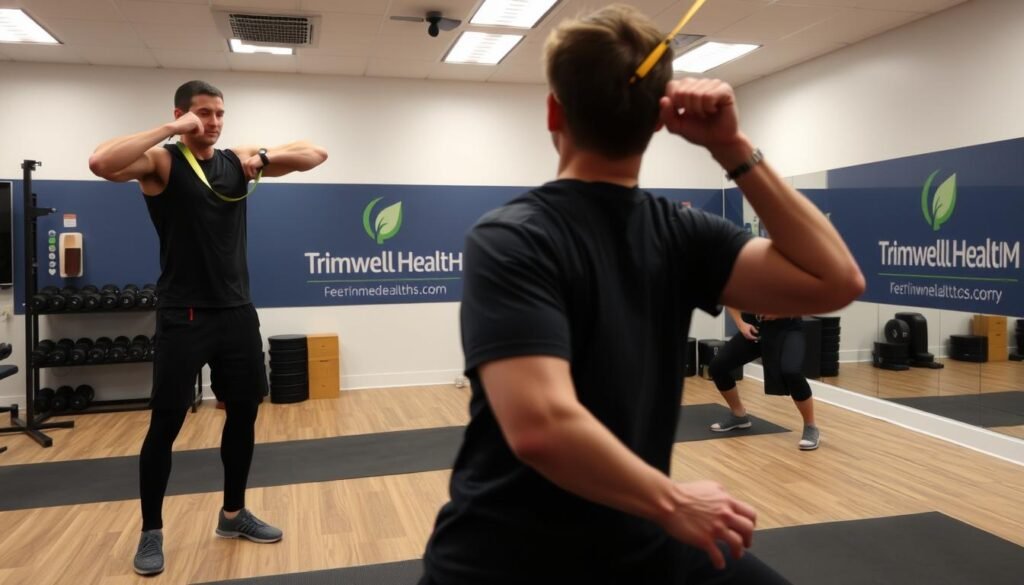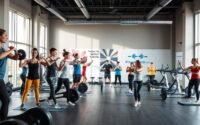Essential Mobility Drills for Deskbound Workers
Have you ever stared at a screen for hours, feeling tired? You’re not alone. Many of us spend a lot of time sitting at desks. This can lead to health problems.
But there’s good news. Adding mobility drills to your day can change things. Simple exercises at your desk can fight the effects of sitting too much. They make workdays better and more fun.
Doing mobility exercises at work is more than staying fit. It’s about feeling alive again during the day.
Key Takeaways
- Mobility drills are essential for combating the adverse effects of a sedentary lifestyle.
- Integrating desk exercises into your daily routine can improve both physical health and productivity.
- Regular workplace mobility exercises can help reduce discomfort from prolonged sitting.
- Taking small breaks for movement can enhance your overall well-being.
- Finding simple ways to stay active during work hours can make a significant difference.
Understanding the Impact of a Sedentary Lifestyle
Today, many people work at desks all day. This leads to a sedentary lifestyle. Studies show over 80% of American workers sit at desks. This can harm their health.
Working at a desk for long times can cause serious health problems. These include musculoskeletal disorders. These are painful and can make it hard to move.
The Rise of Desk Jobs and Health Implications
More people are working at desks. This has made us look closer at the health problems it causes. Sitting for hours can hurt your neck, shoulders, and back.
Not moving much can lead to chronic pain and obesity. Learning about ergonomics at work can help. Making small changes can make a big difference.
For more tips on improving your health, check out this link.
Common Health Issues Faced by Desk Workers
Working at a desk can cause many health problems. Musculoskeletal disorders are common. These can be very painful and affect your spine.
Companies are trying to make work healthier. They offer breaks for stretching and exercises. This can help reduce health risks.
Benefits of Mobility Drills for People Who Sit All Day
Mobility drills are great for people who sit a lot. They help improve posture, increase flexibility, and boost mental clarity. These benefits make work better and improve overall health.
Improving Posture and Alignment
Desk workers often have bad posture from sitting too much. Mobility exercises help loosen tight muscles. This leads to better posture and less chance of getting hurt.
Increasing Flexibility and Range of Motion
Being flexible is key for an active life, even when sitting a lot. Mobility exercises make joints more flexible. This helps with movement and reduces pain during activities.
Enhancing Mental Clarity and Focus
Moving while working helps your brain. Mobility exercises improve blood flow, making you think clearer and focus better. This keeps you productive even when sitting for a long time.
Essential Mobility Exercises to Combat Sedentary Habits
Staying active is hard when you sit for hours. Adding essential mobility exercises to your day can help a lot. These exercises work on muscles that get tight and weak from sitting too much.
By focusing on these muscles during breaks, you can feel better. This can also stop health problems from happening later.
Focusing on Key Muscle Groups
It’s important to work on muscles that get tight from sitting. Leg swings, hip bridges, and shoulder rolls are good for this. They make your body more flexible and help you move better.
Doing these exercises regularly makes it easier to stay active. You’ll feel less stiff and more ready to move.
Exercises for Back and Shoulder Relief
Exercises for your back are key if you sit a lot. Simple moves like desk push-ups and torso twists can help a lot. They make your back and shoulders feel better.
These exercises fight the bad effects of sitting. They help you stand up straight and lower the chance of getting hurt. Adding them to your day makes your body stronger for everyday tasks.
Diverse Desk Exercises for Daily Integration
Making time for exercise at work can be tough. But, small desk exercises can help you stay active and full of energy. Quick desk movements make it easy to fit these activities into your day, improving your health.
Quick Movements to Keep You Active
Start with simple desk exercises like calf raises and chair squats. They need little space and take just a few seconds. Doing these often boosts blood flow and fights sitting sickness.
- Calf Raises: Stand and lift your heels off the ground, holding for a moment before lowering back down.
- Chair Squats: Stand in front of your chair, lower your body as if sitting down, then rise back up.
- Wrist Rotations: Stretch your arms out and rotate your wrists in circular motions to reduce stiffness.
Incorporating Stretches into Your Workday
Use reminders to stretch every 20-30 minutes. It boosts flexibility and energy. Simple stretches like neck rolls and back bends ease tension from sitting too long.
| Stretch | Duration | Benefit |
|---|---|---|
| Neck Rolls | 30 seconds | Reduces neck stiffness |
| Seated Torso Twist | 30 seconds | Relieves back tension |
| Shoulder Shrugs | 30 seconds | Alleviates shoulder tightness |
Adding these activities to your daily routine makes your workday more varied and active. It leads to a healthier, more balanced day at work.
Seated Stretches to Revitalize Your Day
Working at a desk can be tough. But, simple stretches can help a lot. Neck rolls and shoulder shrugs are easy to do. They make you feel better and reduce stress.
Doing these stretches helps your body and mind. You’ll feel more relaxed and focused at work.
Simple Moves You Can Do at Your Desk
Here are some easy stretches you can do at your desk:
- Rubber Neck: Gently tilt your head to each side. Hold for a few seconds to relax your neck.
- Look Around: Slowly rotate your head from side to side for a gentle stretch.
- Seated Lat Stretch: Reach up with both arms and lean to each side.
- Seated Spine Twist: Turn your torso to the right and left to stretch your spine.
Benefits of Frequent Stretching
Stretching at your desk is good for you. It makes you more flexible and focused. It’s also a break for your mind.
Stretching helps you work better and feel less tired. It makes your work place happier.
| Stretch | Hold Time | Repetitions | Benefits |
|---|---|---|---|
| One Arm Hug | 30 seconds | 2-3 times each arm | Stretches shoulders and upper back |
| Office Chair Back Stretch | 30 seconds | 5 times | Relieves back tension |
| Hamstring Chair Stretch | 30 seconds | 3-5 times | Promotes flexibility in the legs |
| Seated Tricep Stretch | 30 seconds | 2-3 times each arm | Improves arm flexibility |
| Wrist Stretch | 15 seconds | 5 times | Increases wrist flexibility |
Strengthening Drills to Complement Mobility Exercises
Adding strengthening drills to your routine is great. It makes your posture better and helps your muscles. Doing exercises for your upper and lower body is good. It fights the bad effects of sitting too much and makes you more flexible and agile.
Upper Body Strengthening Techniques
Exercises for your upper body are key to getting stronger and avoiding injuries. Try desk planks and tricep dips to work out important muscles. These exercises help keep your shoulders and arms stable and can be done at your desk.
- Desk Plank: Hold a plank against your desk to work your core, shoulders, and arms.
- Tricep Dips: Do dips on your desk’s edge to strengthen your triceps and boost upper body strength.
Lower Body Mobility and Strength Drills
Keeping your lower body mobile is vital for being strong and functional. Hip extensions and internal hip rotations help fight stiffness from sitting too long. These drills boost your lower body’s mobility and strength.
- Hip Extensions: Stand and lift one leg back while keeping your body straight to work your glutes and hamstrings.
- Internal Hip Rotation: Sit or stand and rotate your thighs inward to improve hip flexibility and strength.

Effective Workplace Mobility Exercises
Moving more at work can make you healthier and more productive. A good office routine with movement helps fight sitting sickness. Making small changes can make a big difference.
Creating an Office Routine Around Mobility
Make time for movement during breaks. Stand or stretch every hour to refresh your body and mind. Here’s how to start a mobility routine:
- Schedule a ten-minute mobility break every hour.
- Incorporate stretches that can be done right at your desk.
- Consider office workouts that can be performed with minimal equipment.
Combining Exercise with Your Work Tasks
Do light exercises while you work. This keeps you moving all day. Try these tips:
- Stand during phone calls to engage your muscles.
- Use your lunch break for a brisk walk around the office.
- Hold walking meetings to encourage mobility and collaboration.
| Activity | Benefit | Duration |
|---|---|---|
| Standing Desk Usage | Reduces posture-related discomfort | All day |
| Quick Stretching | Increases flexibility and reduces tension | 5 minutes per hour |
| Walking Meetings | Enhances creativity and reduces stress | 30 minutes |
| Desk Exercises | Targets key muscle groups | 10 minutes during breaks |
Focus on these mobility exercises to improve your health and work space. Adding movement to your tasks makes work more fun and productive.
Timing and Frequency of Mobility Breaks
Setting up a good schedule for breaks is key to staying healthy while working long hours. Having a plan for when to move helps keep you active. This can make you feel better and work better too.
It’s easy to forget to move when you’re sitting a lot. But, reminders can help. They keep you from getting too stiff or tired.
Setting Reminders for Frequent Movement
Using timers or apps can help you move more often. Getting up every 20-30 minutes can change your day. It makes you more active and keeps you from getting stiff.
Short Breaks vs Longer Exercise Sessions
It’s good to exercise a lot, but short breaks are important too. Quick movements can help a lot. They make you feel better and help you focus.
| Break Type | Duration | Benefits |
|---|---|---|
| Short Breaks | 1-5 minutes | Improves circulation, enhances focus, reduces stiffness |
| Longer Sessions | 20-30 minutes | Increased strength, stamina, and overall fitness |
Making the Most of Your Workspace
Creating a great workspace means making it comfy and productive. Good workspace ergonomics help keep workers healthy and focused. Making ergonomic changes can really help, making work better.
Ergonomic Adjustments for Better Mobility
Changing chair height, desk setup, and monitor position can make a big difference. Chairs that support the back and monitors at eye level are key. They help avoid strain and improve movement.
Standing Desks and Benefits of Height Adjustability
Adjustable desks turn a regular desk into something more. They let you switch between sitting and standing. This boosts blood flow and energy. Adjustable desks help avoid sitting too long.

| Feature | Traditional Desk | Adjustable Desk |
|---|---|---|
| Posture Support | Poor chair height can lead to slouching | Encourages a neutral spine position |
| Movement Flexibility | Restricts movement to sitting | Allows transitions between sitting and standing |
| Enhanced Energy Levels | Fatigue can occur from prolonged sitting | Promotes increased alertness and reduces fatigue |
| Long-Term Health | Increases risk of musculoskeletal disorders | Helps mitigate risk by promoting movement |
Knowing how workspace changes affect daily life is key. It helps make a space that supports health and work well.
Tips for Staying Active During Busy Workdays
It’s hard to stay active when work gets busy. But, there are smart ways to move more during the day. Learning how to stay active at work can help you feel better and work better.
Micro-Breaks to Enhance Productivity and Health
Micro-breaks are short times to move around at work. They help your mind and body feel fresh. Studies show they boost your health and focus. Even a few minutes can help a lot.
Here are some ideas for micro-breaks:
- Stand up and stretch every hour.
- Do a quick set of exercises like squats or lunges.
- Take short walks around your office.
Incorporating Walking Meetings
Walking meetings mix work with exercise. Instead of sitting, walk and talk. This helps you move and share ideas better.
Walking meetings have many benefits:
- They spark creativity and ideas.
- They make you feel happier and more motivated.
- They help you focus and remember things better.
Other Lifestyle Changes to Improve Mobility
Improving mobility is not just about exercises. Making lifestyle changes can also help a lot. Eating right and staying healthy are key to keeping your body strong. This helps you move better and do more things easily.
Nutrition’s Role in Mobility and Health
Eating well is important for your body. Foods full of nutrients help keep your muscles strong. They also help you recover faster, making it easier to move around.
- Protein: Helps fix muscles.
- Healthy Fats: Good for your joints and lessens swelling.
- Fruits and Vegetables: Full of vitamins and antioxidants that help your health and movement.
By focusing on what you eat, you can move better and feel less tired. This makes it easier to do mobility exercises every day.
Incorporating General Physical Activity
Doing more physical activities is also important for better mobility. Small changes in your daily life can make a big difference. Here are some ideas:
- Walk or bike to work instead of driving.
- Choose to take the stairs over the elevator.
- Join local sports or outdoor activities on weekends.
These small steps can make you more active. This boosts your energy and improves how well you can move. Being active is good for your body and mind.
| Food Group | Benefits for Mobility |
|---|---|
| Lean Protein | Supports muscle growth and repair. |
| Healthy Fats | Reduces inflammation and supports joint function. |
| Fruits and Vegetables | Rich in antioxidants, reduce oxidative stress. |
| Whole Grains | Provide sustained energy for daily activities. |
Conclusion
Adding essential mobility drills to your day is key for better health and work. These exercises fight the sitting that office jobs bring. They help ease pain and boost both body and mind.
Doing mobility exercises helps keep your posture right, makes you more flexible, and sharpens your focus. It’s easy to stay active at work. Just take short breaks to stretch or walk.
Starting a healthier work life is all about small steps. Mobility drills help fight sitting’s bad effects. They make work more lively and full of energy. Make these activities a priority for a better work-life balance.
FAQ
What are mobility drills for people who sit all day?
Mobility drills are special exercises for those who sit a lot. They help improve flexibility, posture, and muscle strength. This makes daily tasks easier and more fun.
How can I incorporate desk exercises into my work routine?
Add desk exercises by setting reminders to move every 20-30 minutes. Try chair squats, calf raises, and seated stretches. These can be done all day without stopping your work.
What are some effective seated stretches I can do at my desk?
Good seated stretches include the “Rubber Neck” stretch, torso twists, and shoulder rolls. These stretches help relieve tension and improve movement at your desk.
Why is it important to address health issues related to a sedentary lifestyle?
It’s key to tackle health problems like neck pain and back discomfort. These issues can get worse over time. Doing mobility exercises can help avoid these problems and improve your health.
What are the benefits of frequent stretching during the workday?
Stretching often boosts flexibility and acts as a mental break. It increases productivity and lowers stress. It also improves blood flow and keeps your mind active.
How do mobility drills improve posture and alignment?
Mobility drills stretch tight muscles from sitting too long. They also strengthen weak areas. This balance helps keep your posture healthy and reduces injury risk.
Can I do strength exercises at my desk?
Yes, you can do desk push-ups, tricep dips, and desk planks at work. These exercises can be added to your busy day to build strength.
What adjustments should I make to my workspace to improve mobility?
Make your chair and monitor height ergonomic for comfort. Using a standing desk can also encourage more movement.
How can I promote an active lifestyle beyond work?
Add more physical activity outside work, like walking or cycling. Even hobbies can help improve your mobility and health.


